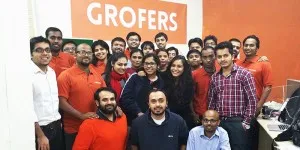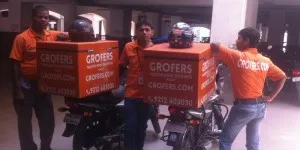Grofers bullish about their B2C model, clocks INR 1.8 crore GMV on monthly basis
Hyperlocal is a new buzzword in Indian startup ecosystem. The sector has not only attracted startups even biggies like Amazon is harping on opportunities in hyperlocal market through Amazon KiranaNow in Bangalore. One of the early entrant in the space is Gurgaon based Grofers. The brainchild of Saurabh Kumar and Albinder Dhindsa Grofers had a humble beginning in a shop in Sushant Lok (Gurgaon).
“The initial idea was to put a website for local needs but it didn’t work. We have made a lot of mistakes before arriving at viable business proposition,” says Albinder. By January 2014 the company started delivery of grocery and FMCG goods for businesses in Gurgaon with four delivery boys. Within 15 months the Sequoia funded venture has over 200 on-field delivery boys and 40+ people in tech, operation and marketing units.

“We were keen to have sustainable business model right from the beginning. Within three months of starting up we were processing orders worth Rs. 8 lakh (for third party merchants in B2B space) on a daily basis,” adds Albinder. In December of 2014, the company came out with its mobile applications so users could order directly from the platform. Initially, Grofers didn’t run a single marketing campaign around their app. “We simply didn’t do marketing. I think it doesn’t work,” he chuckles.
The duo believes if you have a good product users will simply find you.
Unlike e-Commerce ventures Grofers has less than 50% orders driven via Cash on Delivery (COD). “We have noticed customers usually choose COD for first three deliveries and later embrace online payment mode to avoid hassle for change etc.,” points out Albinder.
Food delivery is not sexy enough to be explored
Before starting entrepreneurial journey Albinder worked with Zomato, however Grofers never thought to get into this. “We didn’t and will not get into food delivery space. We commit 90 minutes delivery timeline while food has to be delivered in 15-30 minutes,” notes Albinder.
Currently, the company delivers grocery and bakery products, pet products, flowers and fresh produce. Going forward we will launch pharma and electronics appliances (like charger, extension cords etc.). Grofers has presence in Delhi (NCR), Mumbai and Bengaluru. “We will also roll out to Hyderabad and Pune this year,” adds Albinder.
At present the company processes 400-500 orders (Feb-March) through the mobile app (through consumer facing platform, not for third party merchants) on a daily basis with average basketsize of Rs. 800. “Mumbai seems to be

good market as people are habitual of ordering local needs via online and app,” points out Albinder. This puts the daily sales volume at INR 4 lakhs which was at one point in time at INR 8 lakhs. This reduction is mainly because of the shift from their B2B to B2C model.Grofers makes revenue via commission from retailers. Grocery gives 7-8% margin while bakery offers over 20% margin as MRP issue doesn’t exist in the vertical. The company incurs loss in fruit and vegetable category given the basketsize is small when compared to above two verticals.
While Grofers has an early mover advantage in hyperlocal logistics space, now the company sees competition from start-ups like PepperTap, Zopnow, Bigbasket etc. “Now everyone wants to get into delivery space so we need to run faster,” adds Albinder. For this the company had recently raised $10 million Series A from Sequoia and Tiger Global.
The company is on track to do about Gross Merchandise Value (GMV) Rs.6 lakh (in current month) on a daily basis in April and will post close to 1.6 crore turnover in current fiscal - mainly on the back of their B2B business, which is being ramped down. “Earlier we were profitable but now we are incurring losses to grow and scale our consumer model fast,” adds Albinder.
Fulfilment is a big challenge
Initially the duo thought of pushing product first without worrying much on fulfilment part but it proved to be a blunder for them. “Fulfilment was a big challenge. Going forward we corrected this and discovered the right approach as far as fulfilment is concerned.







